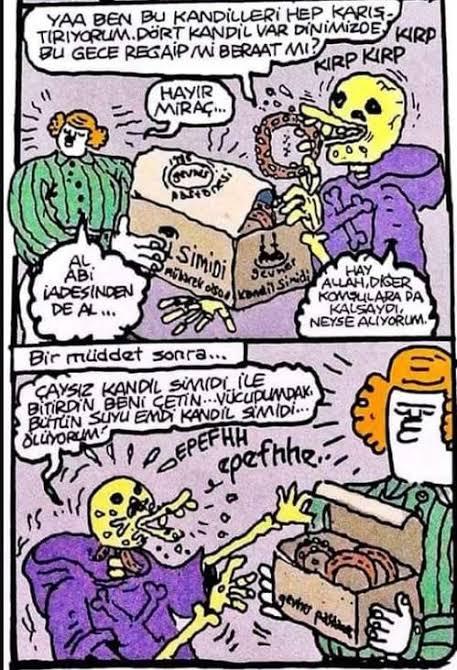Kandil Geleneği.. #MiracKandili https://t.co/jOXKi8rRtI
YAA BEN BU KANDILLERI HEP KARIS. TIRIYORUM. DORT KANDIL VAR DINIMIZDE KIRP BU GECE REGAIP I BERAAT MI? KIRP KIRP AL ABi IADESINDEN DE AL… HAYIR MIRAÇ… 15 T (GIVNLS) ANTON Simini mübarek olsad Bir müddet sonra… CAYSIZ KANDIL SMIDI ILE BITIRDIN BENI CETIN…VUCUDUMDAK. BUTUN SUYU EMDI KANDIL SMIDI… OLUYORUM SEPEFHH HAY ALLAH,DIGER KOMŞULARA PA KALSAYDI NEYSE ALIYORUM. Kandil Sinidi epefnhe… gevher pastant (6)) Bu Tod’s
Kaynak
The image is a comic strip, likely from a Turkish newspaper or magazine. The panels depict a humorous situation about the difficulties and hardships associated with the Islamic religious holidays, specifically emphasizing the consumption of sweets ("şimdi") and the associated struggles or experiences. **Panel 1:** A character is questioning whether it's a *Regaip* or *Berat* night (two important Islamic nights). Another character, depicted as a skeleton (possibly a humorous representation of death or a person who is being affected negatively by the situation), reacts to the question. **Panel 2:** A figure is receiving something, a box likely containing "şimdi" (Turkish for a type of sweet bread). The skeleton appears to be struggling or having a difficult time in receiving and consuming it. A commentary is present with a dialogue about the hardship experienced by the character. **Panel 3:** The subsequent panel shows the continuation of the "şimdi" eating or receiving experience, highlighting the difficulties or struggles involved. Text emphasizes the character's suffering. **The Joke (in Turkish):** The humor stems from the exaggeration of the unpleasantness and hardship associated with the abundance of sweets during religious holidays. The comic strip satirizes the cultural expectation of consuming large quantities of these treats, which can be very taxing or even cause some discomfort. The image of a skeleton further emphasizes the negative impact on the character's well-being. The overall message is one of lighthearted mockery of the social custom without outright criticism or harm. The use of "şimdi" to represent these sweets is a cultural and linguistic element which would be better understood by Turkish speakers. The tone is light-hearted and satirical, not critical.

Henüz bişi yazılmamış